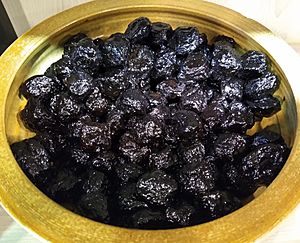Smoked plum facts for kids
Smoked plums are dried and smoked fruits from the Asian plum tree. People use them in cooking and traditional medicine across East Asia. You might hear them called wūméi in Chinese, omae in Korean, ubai in Japanese, or Ô mai in Vietnamese.
Contents
What Are Smoked Plums Like?
Smoked plums are usually dark brown or black. They have a rough, wrinkled surface. These plums have a special, sour taste. Each fruit is shaped like a ball or is slightly flattened. They are about 2 to 3 centimeters long. The plum has a hard seed inside.
How Are Smoked Plums Made?
To make smoked plums, people pick unripe plums in early summer. These plums are then smoked and dried. This drying process happens at a temperature of about 40 degrees Celsius (104 degrees Fahrenheit).
How Are Smoked Plums Used?
Smoked plums are used in many ways. They are popular in drinks, traditional medicine, and even for dyeing.
Smoked Plums in Cooking
- In China, smoked plums are used to make a popular drink called suānméitāng. This drink is known for its sour taste.
- In Korea, smoked plums are used to make traditional teas and drinks. Examples include omae-cha (smoked plum tea) and jeho-tang, which is a special summer drink.
Smoked Plums in Traditional Medicine
In traditional medicine, smoked plums are known by the Latin name Mume Fructus.
- In Traditional Korean medicine, people believe smoked plums help different parts of the body. They are used to help with issues like coughing or stomach problems.
- Studies have shown they might help reduce phlegm and fight certain bacteria.
Smoked Plums for Dyeing
In Japan, an extract from smoked plums (called ubai) is used in dyeing. It acts as a mordant. A mordant helps natural dyes stick better to fabric. It is often used with the natural red dye from safflower flowers.



